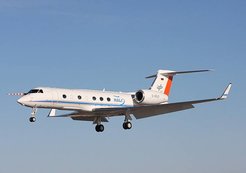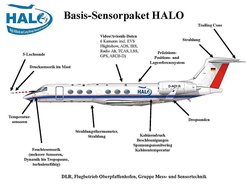Research aircraft HALO
Higher, farther, HALO
HALO, the High Altitude – LOng-range research aircraft opens new horizons for the German atmospheric research community.

The Gulfstream G550 can transport three tons of scientific equipment up to 15.5 kilometers altitude, over distances of more than 10.000 kilometers. Several air intakes and equipment mountings allow diverse studies of the traversed air masses.
Why are research airplanes necessary?
Aircraft measurements close the observational “gap” between ground-based and satellite measurements. They are particularly valuable to describe processes at the different scales on which physical and photochemical processes take place. The observed spatial variability for clouds, aerosols, water vapor and ozone, for example, spans several orders of magnitude: from less than 100 m for turbulent processes to more than 1000 km in the case of synoptic weather systems. Furthermore, aircraft can capture a high temporal resolution: Atmospheric oxidation processes usually involve radical reaction chains, whose lifetime is very limited. Therefore, chemical measurements must typically be performed at a time resolution of seconds to minutes. The same applies to the interactions of aerosols and clouds, and many other phenomena.
What is so special about HALO?

HALO can fly farther and higher, while carrying more equipment, than any other German research aircraft. Therefore, HALO will significantly increase the fraction of the global atmosphere accessible to direct measurements. With its relatively large size, HALO can transport a suite of instruments to measure simultaneously a range of physical and chemical parameters. Such comprehensive measurements may involve instruments developed in institutes in Germany and internationally. They are well suited to characterize atmospheric processes including transport, radiation and chemistry. Overall speaking: HALO greatly improves the airborne research capability for German research institutes and universities to study atmospheric phenomena and their interactions from local to global scales.
What research does the ESRP plan with HALO?
Currently, six HALO-missions are planned under the leadership or with significant participation of ESRP partner institutes:
Acronym | Description |
|---|---|
ACRIDICON | aiming at aerosol-cloud-precipitation interactions and their dynamic and radiative effects in convective cloud systems by combination of in-situ aircraft observations with remote sensing (aircraft, satellite, and ground based) and numerical simulations, coordinated by the MPI-C and the Institute for Tropospheric Research, Leipzig. |
BARBADOS | studying the controlling factors for the distribution and vertical structure of clouds and precipitation in the trade-winds, coordinated by the MPI-M |
CIRRUS | dealing with the influence of airplane emissions on cirrus clouds, coordinated by the MPI-C |
NARVAL | studying the rainfall over the north Atlantic and its fluctuations, coordinated by the MPI-M |
OMO | Oxidation Mechanisms Observations, dealing with the self-cleansing ability of the atmosphere, coordinated by the MPI-C |
TACTS | studying transport processes of trace compounds in the lower and lowermost stratosphere, coordinated by the University of Frankfurt, with participation of MPI-C |
HALO will be operated out of the German Aerospace Center (DLR) facilities in Oberpfaffenhofen. It is available for the German atmospheric research community, which supports its operation. The largest part of the budget is covered by the German Ministry of Research and Education. Further finances are contributed by the Max Planck Society and the Helmholtz Association, which includes the DLR.

